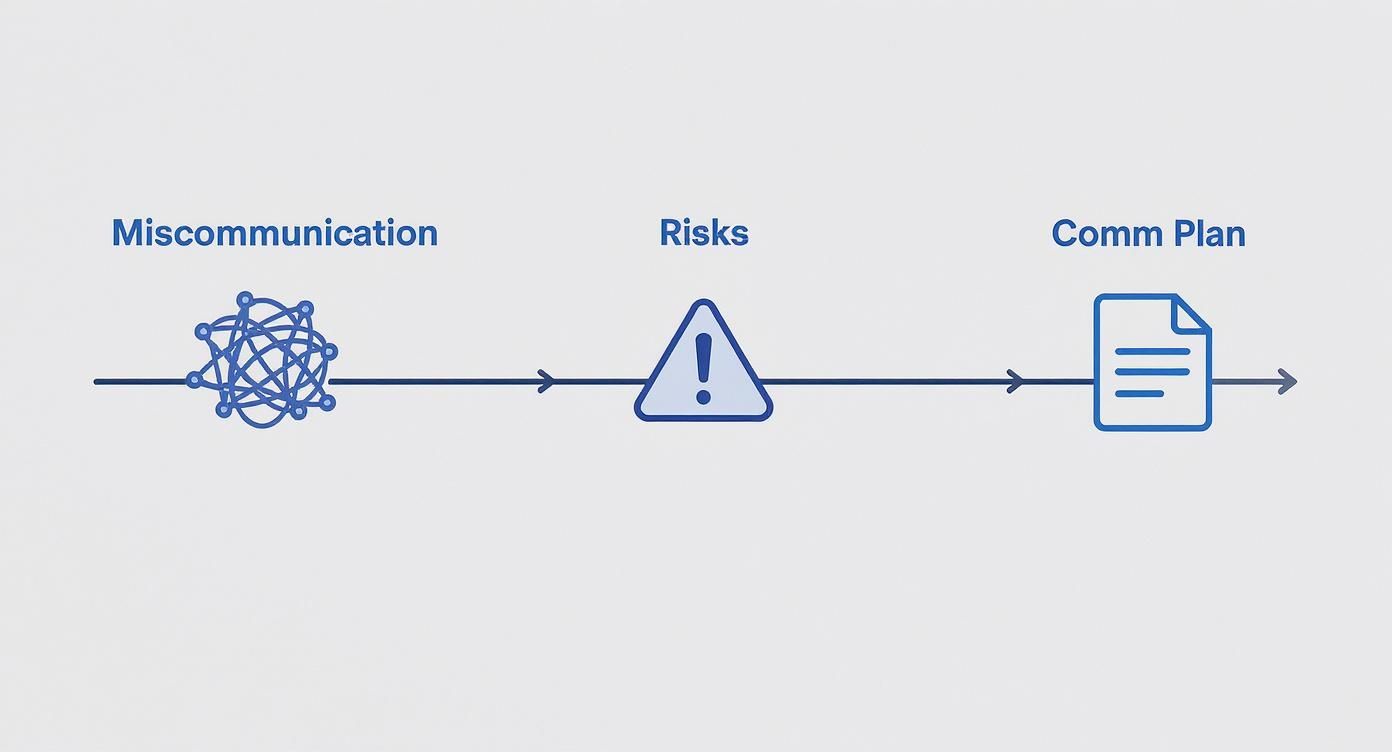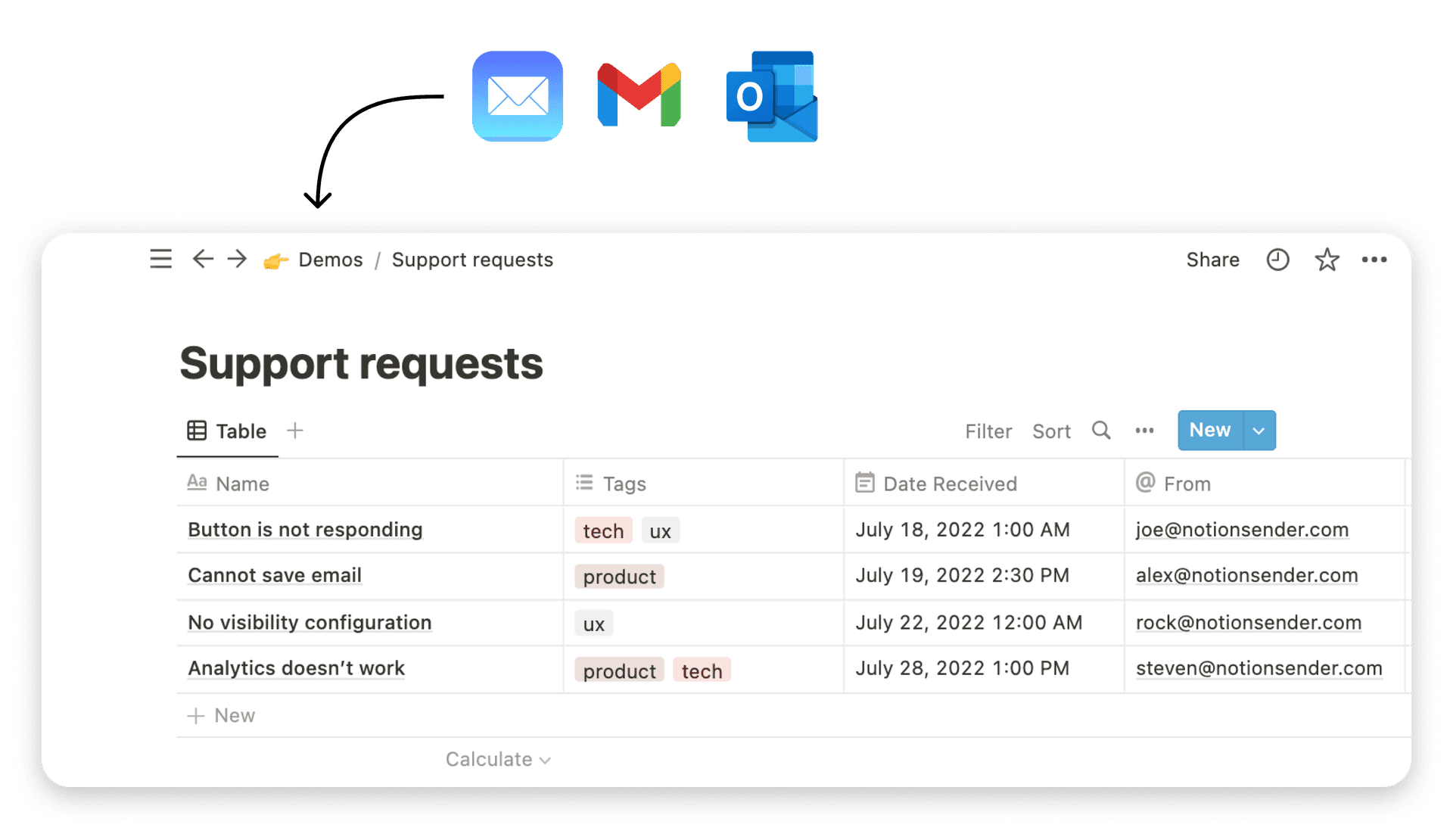A Practical Stakeholder Communication Plan Template

A good stakeholder communication plan is your secret weapon for keeping everyone on the same page. It’s a simple blueprint that maps out who needs to hear what, when they need to hear it, and the best way to get that message across. Think of it as preventing misunderstandings before they even have a chance to start.
Why a Communication Plan Is Your Project's Lifeline
Let's be real for a minute. Most project failures can be traced back to one culprit: a communication breakdown. We've all seen it happen. A project kicks off with a ton of energy, but before you know it, key people are out of the loop, expectations are all over the place, and everything just… stops.
The marketing team finds out about a major feature change from a customer. The executive sponsor gets blindsided by a budget issue during a board meeting. These aren't just one-off mistakes; they're symptoms of a missing communication strategy. When you don't have a plan, communication becomes reactive, chaotic, and usually, way too late.
Moving Beyond Accidental Communication
A stakeholder communication plan isn't just another box to check on your project to-do list. It's the proactive fix for the communication chaos you've probably experienced. The whole point is to shift from random, accidental updates to deliberate, intentional engagement.
This structured approach makes sure every single stakeholder—from your CEO down to the end-user—gets the right information at the right time.
The stakes are higher than you might think. A study from the Project Management Institute (PMI) found that poor communication is to blame for a staggering one-third of all project failures. That number alone shows just how vital a solid plan really is.
A communication plan is your project’s insurance policy against confusion, delays, and frustrated stakeholders. It’s how you build the trust you need to handle the inevitable bumps in the road and keep everyone rowing in the same direction.
The Real-World Impact of a Plan
Picture this: you're launching a new software feature. Without a plan, the dev team is siloed, engineers push updates without telling the support team, and sales is out there promising a feature that's just been delayed. The result? A ton of internal friction and a messy customer experience.
Now, imagine that same launch, but with a communication plan in place:
- Executive sponsors get a bi-weekly summary email showing progress against key goals.
- The marketing team has a dedicated Slack channel with weekly updates so they can prep launch materials.
- Customer support gets a monthly demo to see new features long before they go live.
Suddenly, everyone's in sync. The plan minimizes surprises, clarifies who's responsible for what, and creates a truly cohesive team. This kind of organization is a lifesaver, especially when you have to manage multiple projects effectively and keep dozens of people in the loop without burning everyone out. It turns communication from a major project risk into your greatest strength.
Identifying and Analyzing Your Stakeholders
You can't build a solid communication plan without knowing exactly who you’re talking to. It sounds obvious, but you'd be surprised how many projects skip right over this crucial first step: stakeholder identification and analysis. It’s the foundation that every other part of your plan rests on.
Your first move is to just brainstorm everyone—and I mean everyone—who has a stake in your project. This isn't just about listing the obvious people like the project sponsor or your core team. You need to think much, much broader.
Consider all your internal and external groups. Internally, you could have anyone from the CEO and department heads down to the IT support staff who will eventually manage the new system. Externally, this list might include customers, suppliers, regulatory bodies, or even community groups affected by what you're doing. Cast a wide net. At this stage, no one is too minor to add to the list.
From a Simple List to a Strategic Analysis
Okay, so you have your big list. Now what? A simple list of names doesn't tell you how to communicate with them. You need to dig deeper to understand their relationship with the project, what they truly care about, and how much influence they really have. This is where the analysis begins.
A good stakeholder analysis will help you categorize people based on their level of influence and interest, which is key to prioritizing your efforts. For example, a high-level executive might only need updates on major risks, while your end-users will be far more interested in project milestones and how it affects their daily work. You can explore a detailed stakeholder communication matrix to see how this plays out in practice.
This infographic really drives home how a solid communication plan can turn potential chaos into managed success.

It’s a great visual reminder that connects the dots between unclear communication, project risks, and the strategic solution you're building right now.
Using the Influence-Interest Grid
One of the most effective tools I've used for this is the Influence-Interest Grid. It’s a simple but powerful matrix that helps you categorize stakeholders into four distinct groups, which then dictates your communication strategy for each one. It's a fantastic way to visualize your entire stakeholder landscape.
The grid is built on two simple axes:
- Influence: How much power does this person have to affect the project’s outcome? Can they stop it, change its direction, or secure critical resources?
- Interest: How much is this person actually affected by the project’s outcome? Are they in the weeds every day, or just watching from a distance?
Plotting each stakeholder on this grid gives you an instant, visual guide for where to focus your energy. You absolutely cannot treat every stakeholder the same way, and this grid ensures you don’t.
To make this more tangible, let's build a quick matrix to help visualize these categories.
| Stakeholder Category | Description | Communication Strategy |
|---|---|---|
| High Influence / High Interest | Your key players. They have significant power and are deeply invested in the outcome. Think project sponsors or lead clients. | Manage Closely: Engage them frequently and deeply. Involve them in key decisions and provide detailed, regular updates. |
| High Influence / Low Interest | Powerful figures who aren't involved day-to-day, like a CEO or department head. They can step in if things go south. | Keep Satisfied: Give them concise, high-level summaries. Keep them confident without drowning them in details they don't need. |
| Low Influence / High Interest | People directly impacted but with little formal power, like the end-users of your product. Their buy-in is critical. | Keep Informed: Provide regular, relevant updates through newsletters or demos. Make them feel heard and valued. |
| Low Influence / Low Interest | Individuals on the periphery, such as other departments. They have minimal power over the project and aren't heavily invested. | Monitor: Communicate with minimal effort, like a mention in a company-wide update. Keep an eye on them in case their status changes. |
This table neatly sums up how you can tailor your approach based on where each stakeholder lands.
Tailoring Your Approach for Each Quadrant
Let's break down those four quadrants from the grid a bit more.
1. High Influence, High Interest (Manage Closely) These are your MVPs—the project sponsor, core team leads, maybe a major client. They are deeply invested and have the power to make or break your project.
- Strategy: You need to engage them fully and frequently. Pull them into key decisions, send them detailed and regular updates, and schedule one-on-one meetings. Their support is absolutely critical, so you have to actively manage their expectations.
2. High Influence, Low Interest (Keep Satisfied) This group often includes senior executives or heads of departments who aren't directly involved but hold a lot of authority. They don’t need the nitty-gritty details, but they can certainly exert their influence if they become unhappy.
- Strategy: Give them concise, high-level summaries. The goal is to keep them informed enough to feel confident in the project's progress without overwhelming them with information they don’t care about. A bi-weekly executive summary email usually hits the mark.
Remember, the goal of stakeholder analysis isn't just to make a list. It's to build a strategic empathy map that lets you see the project from multiple perspectives and communicate in a way that resonates with each one.
3. Low Influence, High Interest (Keep Informed) This quadrant is typically filled with the end-users of your product or service. While they might not have the power to halt the project, their buy-in and feedback are essential for its ultimate success and adoption.
- Strategy: Keep them in the loop with regular, relevant information. Think newsletters, group demos, and Q&A sessions. They need to feel heard and understood, so opening up channels for feedback is vital.
4. Low Influence, Low Interest (Monitor) These are the stakeholders who are only peripherally connected to the project, like folks in other departments. They don't have much sway over the outcome and aren't heavily invested.
- Strategy: Provide general information with minimal effort. A mention in a company-wide newsletter or a quick post on an internal blog is usually enough. Just keep an eye on them to make sure their position doesn't shift unexpectedly.
Building Your Stakeholder Communication Plan Template
Alright, you've done the hard work of identifying and analyzing your stakeholders. Now it’s time to put that knowledge to work by building a structured, actionable plan. This is where we move from theory to practice, creating the very backbone of your communication strategy.
A solid stakeholder communication plan template is your single source of truth for engagement. Think of it less as a boring spreadsheet and more as a clear, repeatable process for keeping everyone in the loop and on your side. Every single column and row has a purpose, turning your analysis into a concrete game plan. Let's break down exactly what you need to build a template that will work for any project you throw at it.

Core Columns of Your Template
Your template needs to be more than just a list of names and titles. It's a dynamic guide that maps out every single part of your communication strategy. To really make it effective, you need columns for stakeholder names, their roles, influence levels, preferred communication methods, and how often you'll be in touch.
Here are the must-have columns I always include in my plans:
- Stakeholder Name & Role: The basics. Get their full name and official title right (e.g., "Jane Doe, Head of Marketing"). No nicknames here.
- Contact Information: At a minimum, their primary email. Add a phone number if it’s appropriate for their level of engagement.
- Influence/Interest Level: This is where that analysis pays off. Note their category, like High Influence/High Interest. This context is gold for anyone on the project team who needs to get up to speed quickly.
- Key Interests & Motivations: What do they actually care about? Jot down their main concerns or what they hope to get out of the project. Think specifics like, "Concerned with budget adherence," or "Focused on user adoption rates."
Defining the "What" and "Why" of Communication
Once you have the "who" nailed down, your template needs to tackle the "what" and the "why." This part forces you to make every piece of communication intentional and tailored to the person receiving it. You’re not just blasting out updates; you're delivering specific information designed to meet a very specific need.
This means you have to ditch the generic messages. For instance, your executive sponsor doesn’t need a notification about a minor bug fix, but they absolutely need a heads-up about a potential budget overage. On the flip side, the dev team needs the nitty-gritty details on that bug fix but could care less about the high-level financial summary.
Your template should force you to be intentional. For every stakeholder, ask: What is the one key message they need to hear right now, and what action or feeling do I want this communication to inspire?
This laser-focused approach stops you from drowning people in information and makes sure your most important messages actually get noticed.
Detailing the "How" and "When"
The last crucial pieces of your template are all about logistics. A brilliant message sent at the wrong time or through the wrong channel is just as useless as no message at all. This is where you hammer out the specific mechanics of your plan.
Key logistical columns to include:
- Communication Method/Channel: Be specific. Don't just write "meeting." Is it a "Weekly 30-min Zoom Stand-up" or a "Bi-weekly Formal Status Report (PDF via Email)"? Clarity here prevents any confusion.
- Frequency: How often will you connect? Options could be Daily, Weekly, Bi-weekly, Monthly, or even "As-Needed at Milestones."
- Owner: Who is hitting 'send'? Assign a specific person, like the "Project Manager" or "Tech Lead." This builds clear accountability.
- Notes/Feedback Loop: This is a living column. Use it to track specific requests, feedback you've received, or adjustments to the plan. For example: "Requested more data on user engagement metrics in the next report."
Here’s a quick look at how a single row in your template might look once it's filled out, bringing all these elements together:
| Stakeholder Name | Influence/Interest | Key Message | Method | Frequency | Owner |
|---|---|---|---|---|---|
| John Smith | High/High | Progress against budget and timeline. Any major risks identified. | Formal Email Summary | Bi-weekly | Project Manager |
This level of detail transforms your template from a simple list into a powerful project management tool. It gives you a clear, at-a-glance overview of your entire communication strategy.
For managing a high volume of communication, especially with external stakeholders like customers, looking into a dedicated customer communication management software can be a game-changer. These tools can automate and track many of the touchpoints you've just outlined.
Ultimately, a well-defined stakeholder communication plan template provides the structure you need to keep your project on track and your stakeholders confidently engaged from kickoff to completion.
Choosing the Right Communication Channels
Get this part wrong, and even the most perfectly crafted message is dead on arrival. Picking the right communication method is just as critical as the information you're sharing. It's the difference between an update that gets seen, understood, and acted upon, versus one that's just more noise in a crowded inbox. This isn't a minor detail; it’s a core piece of your stakeholder communication plan template.
You can't just default to email for everything and hope for the best. The channels you pick will literally shape the entire communication dynamic for your project. Think about it: sending a dense, technical project update through a fast-moving Slack channel is a recipe for disaster. So is calling a formal board meeting just to announce a minor timeline tweak. It's about matching the medium to the message—and the audience.

Synchronous vs. Asynchronous Communication
First things first, let's break down your options into two main camps: synchronous and asynchronous. Getting this distinction right is the key to matching the method to the moment.
Synchronous communication is all about real-time, back-and-forth conversation. It’s what you need for complex problem-solving, hashing out ideas, and actually building relationships.
- In-person meetings: The heavyweight champ. Best for high-stakes decisions, sensitive topics, and project kickoffs where you need to build that initial rapport.
- Video calls (Zoom, Google Meet): The modern workhorse for team stand-ups, detailed discussions, and any situation where seeing faces matters but you're not in the same room.
- Phone calls: Still incredibly useful for quick, urgent check-ins or solving a specific problem that needs a direct, two-minute conversation, not a 10-email chain.
Asynchronous communication, on the other hand, doesn't demand an immediate response. This is your go-to for routine updates and non-urgent info, allowing people to process it on their own time.
- Email newsletters: Perfect for those weekly or bi-weekly summaries for a broad group of stakeholders who need to be kept in the loop but not bogged down in the daily grind.
- Project management tools (Asana, Jira, Notion): This is where task-specific updates, progress tracking, and key decisions should live. It keeps communication tied directly to the work itself. We built our own tool, NotionSender, to bridge this gap, letting teams send and receive emails right inside their Notion workspace to keep everything centralized.
- Shared documents and reports: The best way to share detailed status reports or project plans that stakeholders can dig into when they have a spare moment.
One of the biggest mistakes I see is defaulting to synchronous meetings for everything. Respect your stakeholders' time. Use asynchronous channels for simple updates and save the real-time conversations for discussions that actually require collaboration.
Establishing the Right Cadence
Once you've picked your channels, you need to set the rhythm. Your communication cadence is how often you'll send updates through each channel. A good cadence keeps everyone informed without drowning them in notifications.
For example, on a recent software launch, our cadence looked something like this:
- Daily: Quick async stand-up in a dedicated Slack channel for the core dev team.
- Weekly: A 30-minute video call with project leads to tackle roadblocks and review progress.
- Bi-weekly: An email summary to our executive sponsors showing key metrics and budget status.
- Monthly: A live demo for the sales and marketing teams to show off new features.
This layered approach meant everyone got the right level of detail at the right time. The execs weren't getting spammed with daily bug reports, and the dev team stayed perfectly aligned.
To help you map this out, think about the specific needs of each stakeholder group and which channel best serves them.
Matching Communication Channels To Stakeholder Needs
Here’s a quick-and-dirty table to help you match the right channel to the right situation.
| Channel | Best For | Pros | Cons |
|---|---|---|---|
| In-Person Meetings | Sensitive topics, major decisions, team building. | High engagement, builds strong relationships. | Difficult to schedule, requires travel. |
| Video Calls | Collaborative problem-solving, regular check-ins. | Face-to-face interaction, screen sharing. | Can lead to "Zoom fatigue," scheduling issues. |
| Email Newsletters | Regular high-level updates, broad announcements. | Reaches a wide audience, easy to track. | Low engagement, can be ignored or sent to spam. |
| Project Management Tool | Task-specific updates, progress tracking, documentation. | Centralized information, clear accountability. | Requires all stakeholders to adopt the tool. |
Ultimately, what you're aiming for is predictability. When stakeholders know when and how they'll hear from you, they feel more confident and engaged. You're proactively giving them the information they need, which means they won't have to chase you for it. That builds trust and keeps your project moving forward.
Putting Your Communication Plan into Action
You've done the hard work of building a solid stakeholder communication plan. That’s a huge win. But let’s be honest, a plan sitting in a Google Drive folder is just a document. Its real power is unleashed when you actually use it. This is where the rubber meets the road—turning your thoughtful strategy into a set of consistent, real-world actions.
<iframe width="100%" style="aspect-ratio: 16 / 9;" src="https://www.youtube.com/embed/DUE2GqpZbpw" frameborder="0" allow="autoplay; encrypted-media" allowfullscreen></iframe>
The first, most critical step is assigning clear ownership for every single communication task. Who is sending the weekly email summary? Who’s scheduling the monthly demo? If there isn’t a specific name next to each task, you’re inviting trouble. Important updates will inevitably fall through the cracks because everyone assumes someone else is handling it. It's a classic project pitfall called diffusion of responsibility.
Think of the "Owner" column in your template as a contract. Simply putting a name there creates accountability and ensures every message you’ve planned so carefully actually gets out the door.
Build Systems for Consistency and Feedback
With ownership sorted, it's time to build systems that make execution almost automatic. Relying on memory is a surefire way to miss deadlines and create an inconsistent flow of information. You need to use some simple automation to your advantage.
Set up recurring calendar invites for your key meetings. Create automated reminders in your project management tool for report deadlines. For example, if the project manager is on the hook for a bi-weekly executive summary, a simple recurring task that pings them two days before it's due works wonders. These small systems are the backbone of consistency, and consistency is what builds stakeholder trust.
Of course, sending messages is only half the battle. You need to know if they’re actually landing. Creating feedback loops isn't optional; it's essential for keeping your communication plan relevant. This doesn't need to be a big production:
- Tack on a simple question at the end of your update emails. Something like, "Does this summary give you the clarity you need on our progress?" can provide quick insights.
- Save the last five minutes of every stakeholder meeting specifically for open questions and feedback on the communication process itself.
- Send a quick pulse survey once a quarter. Ask your high-interest stakeholders if the frequency and format of your updates are hitting the mark.
This feedback is pure gold. It tells you exactly what’s working, what’s not, and how you can tweak your approach to better serve each person.
Navigating the Inevitable Bumps in the Road
No project is a straight line, and your communication plan will be tested. The true measure of your strategy is how you handle the tough stuff—delivering bad news or re-engaging someone who’s gone radio silent.
Let's walk through a classic scenario: you have to announce a major project delay. Your gut reaction might be to soften the news or wait for a "better time." Don't do it.
The best way forward is to be direct, transparent, and proactive. Rip the Band-Aid off. Address the delay head-on, explain why it happened, share the revised timeline, and clearly state your plan to get things back on track. Your stakeholders will respect the honesty far more than a sugar-coated or late message.
Another common challenge is the checked-out stakeholder. What do you do when a key person stops replying to emails or showing up for meetings? Don't just let it slide. A direct, personal message can make all the difference.
Try a quick note like, "Hi [Name], I noticed we haven't connected in a while. I want to make sure the updates we're sending are still relevant for you. Is there a better way we can keep you in the loop?" It's a simple gesture that shows you value their input and are willing to adapt.
Ultimately, your stakeholder communication plan isn't a static document you create and forget. It has to be a living, breathing part of your project. By assigning clear ownership, creating robust feedback loops, and handling challenges with transparency, you turn your plan from a simple document into a dynamic tool that actively drives your project toward success.
Frequently Asked Questions
Even with a solid template, you'll always run into a few questions when you start putting things into practice. Let's tackle some of the most common ones that pop up when you're building and using a stakeholder communication plan.
How Often Should I Update My Plan?
Your communication plan isn't something you create once and file away. Think of it as a living document. The best time to revisit it is at natural project breaks—like the end of a sprint, the completion of a major phase, or anytime something big changes.
A quarterly review is a good baseline for longer projects, but really, the biggest trigger for an update is change. Did a new risk just pop up? Have you noticed a key stakeholder has suddenly gone quiet? That’s your signal to open the plan and adjust your strategy on the spot.
What Is the Difference Between a Stakeholder Register and a Communication Plan?
This is a really common point of confusion, but the difference is pretty simple when you break it down.
- The Stakeholder Register is your "who" list. It’s basically a directory identifying every stakeholder, what their role is, their connection to the project, and their contact info. It’s the raw data.
- The Communication Plan is your "how, what, and when" strategy. It takes the info from the register and turns it into an actionable playbook. It spells out the specific messages, channels, and frequency you'll use to engage with each person.
One is an inventory, the other is the game plan. You can’t build a good plan without a complete and accurate register first.
A stakeholder register tells you who is in the room. A communication plan tells you how to talk to them so they'll actually listen and stay engaged.
How Do I Manage Stakeholders with Conflicting Interests?
Juggling conflicting interests is one of the toughest—and most important—parts of managing any project. The worst thing you can do is pretend the conflict doesn't exist. Your job is to act as a neutral facilitator and keep communication open and honest.
First, call out the conflict directly in your stakeholder analysis. Your goal isn't to make everyone happy; it's to find a path forward that serves the project's main objectives. A good first step is to hold separate one-on-one meetings to really understand each person’s perspective without the pressure of a group debate.
From there, look for common ground, no matter how small, and tie everything back to the overarching project goals everyone agreed on at the start. When you have to make a tough call that favors one side, be transparent about why. Clearly connect your decision back to the project's documented success criteria. This builds trust and respect, even when a stakeholder doesn’t get exactly what they wanted.
Ready to bring your project and email communications under one roof? With NotionSender, you can send and receive emails right from your Notion workspace, keeping every stakeholder interaction organized and tied to your project. Stop letting important messages get lost in your inbox. Learn more and see how NotionSender works.

